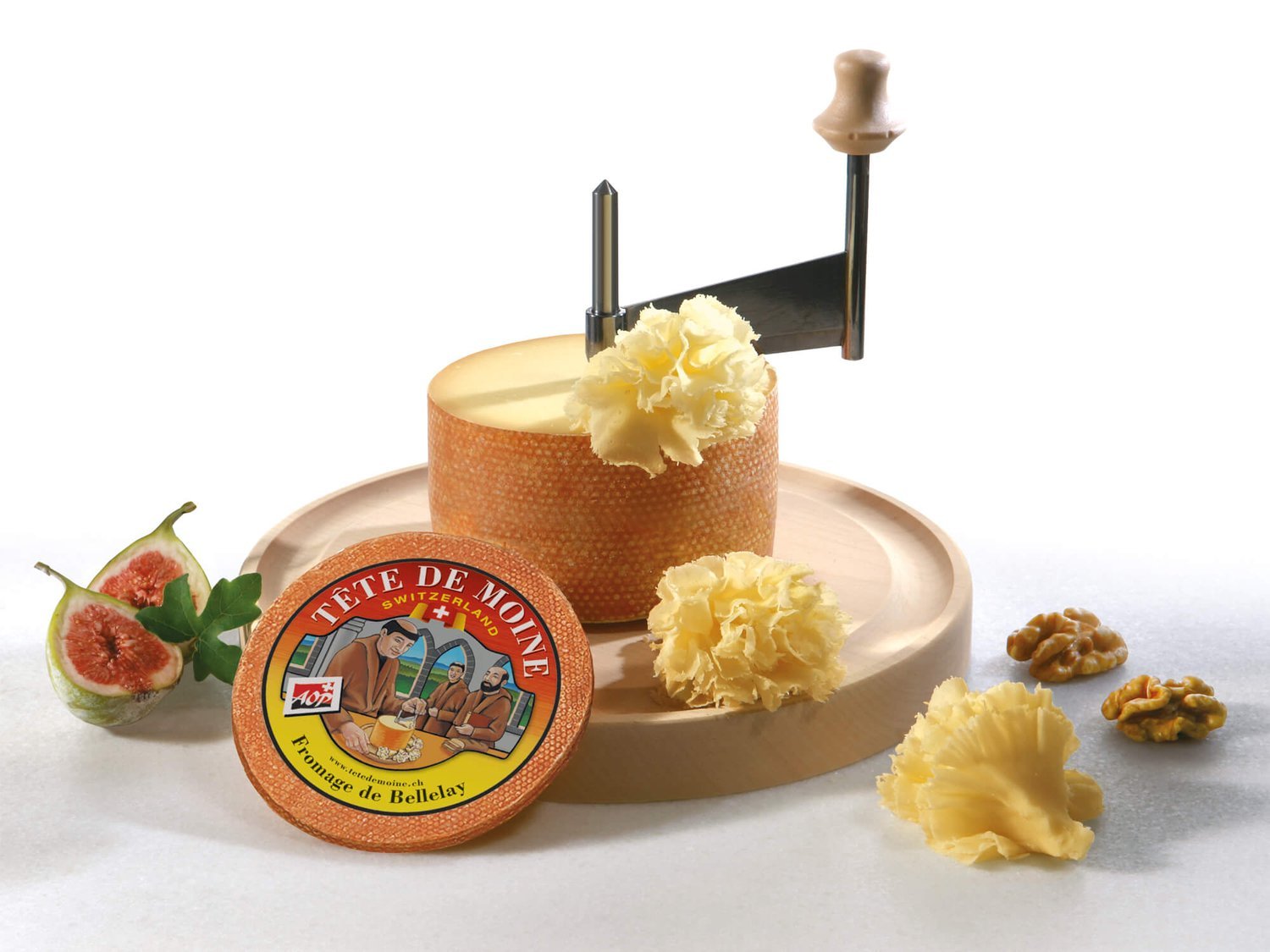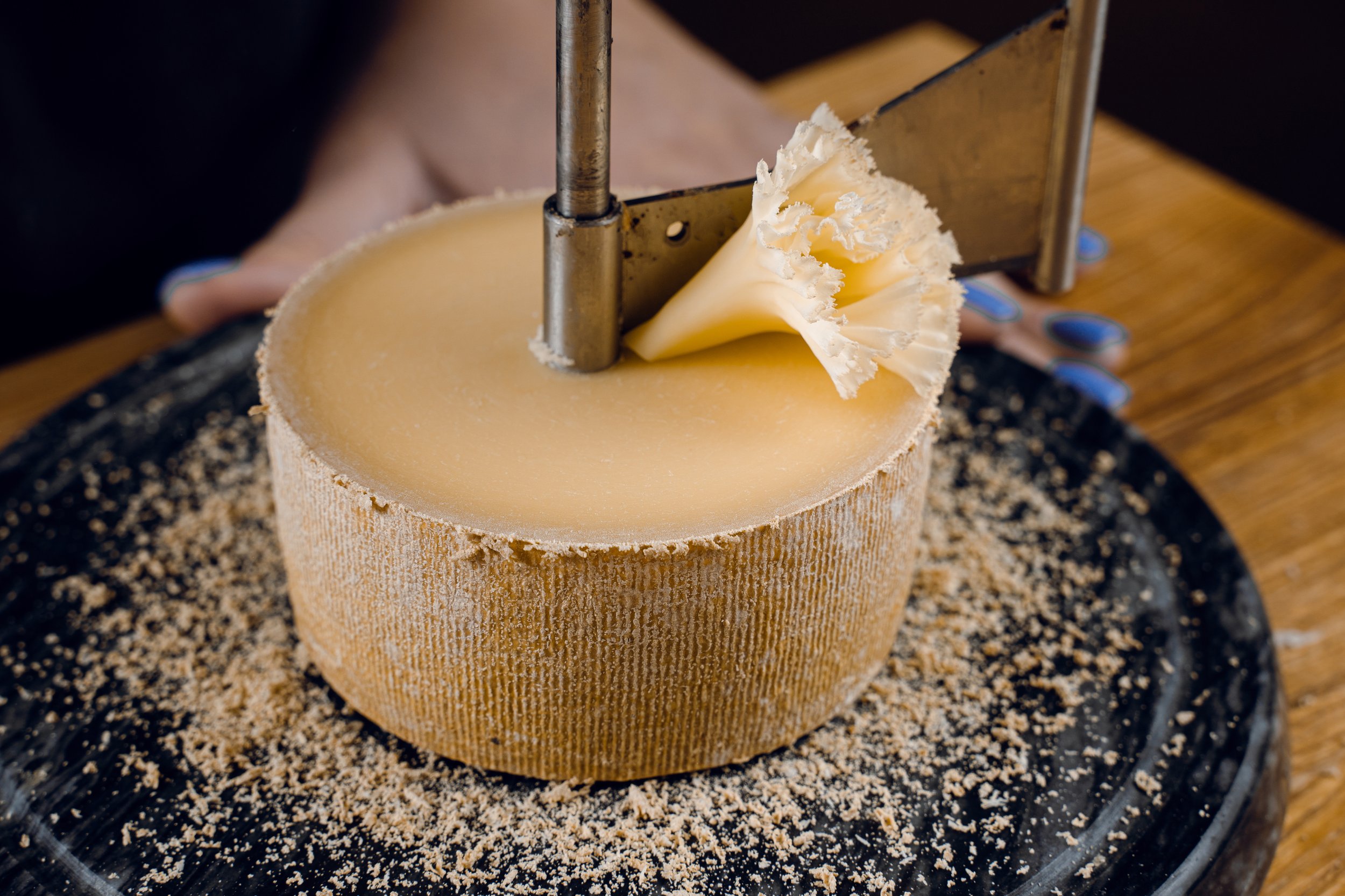Could Tête de Moine AOP Be the Prettiest of All Swiss Cheeses?
Nestled into the undulating peaks and valleys of the Swiss Jura, the small village of Bellelay is home to a beloved cheese. With a history spanning more than 800 years and a one-of-a-kind method for serving it, Tête de Moine AOP is one of Switzerland’s most unique and prettiest dairy products.
"File:B-Bellelay-Abbatiale.jpg" by Roland Zumbuehl is licensed under CC BY 3.0.
The History of Tête de Moine
According to local legend, the Abbey of Bellelay was established in 1136 when Sigingand, the provost of Moutier-Grandval, became lost in the deep woods of the High Jura region while hunting a wild boar. Unable to find his way out of the forest, he vowed to establish a monastery if he returned home safely. Four days later, he emerged from the woods. Keeping true to his vow he built the monastery, naming it “belle laie”, as “laie” was the local word for female boar.
Monks living in the abbey began making cheese shortly thereafter, producing it not only to sustain themselves but also to satisfy the demands of rent by their landlord, the Diocese of Basel. As soon as 1192, records show payment of these rents, or ‘cens’, in the form of cheese. Soon after this practice was established, local farmers took notice and began making similar payments, heightening the amount of wheels produced in the area. This resulted in the abbey moving much of their production to local vacheries who could make larger quantities of cheese for their benefit.
Why is it Called Tête de Moine?
At the end of the French Revolution, the monks were evicted from the abbey by French troops, who then secularized the building. This time also happens to be when the original name of the small cylinders of cheese made there, Fromage de Bellay, was changed to Tête de Moine. Literally translating to “monk’s head”, it is thought the change came from the resemblance the wheels had to the tonsure, or bald spot, of the monks living there. Another theory suggests it may have come from the nickname given to the wheels stored in the cellars of the abbeys, monk heads.
Modest amounts of Tête de Moine continued to be produced in the area until the middle of the 19th century, when local farmer A. Hofstetter won a prize for his cheese at the Paris Universal Competition, increasing the visibility and reputation and exposing it to a more global audience.
Today, more than 3.2 million wheels are produced yearly, with nearly 62% being exported to meet demand. Of all the cheese exported, approximately 81% goes to either Germany or France. To help expand its reputation and presence, a two-day festival has been held at the Maison de la Tête de Moine in Bellelay each year since 2016. The Fête de la Tête de Moine has enjoyed a growing popularity every year, with more than 15,000 people attending in 2022.
Where Does Tête de Moine Come From?
The Jura is one of Switzerland’s three primary geographical regions. Forming a natural border with France, this region covers nearly 10% of the country and includes the cantons of Geneva, Vaud, Neuchâtel, Bern, Jura, Solothurn, Basel-Landschaft and Aargau. It is also home to some of Switzerland’s largest lakes.
Nearly half of the Jura is covered by forest (47%), and virtually as much is also used for agriculture (43%). Of all the land, only 8% is settled. There are mountains, but they are smaller than Switzerland’s more famous alps to the south. The highest peak here is Mont-Tendre, standing at 5,508 feet.
Dairy is by far the dominant industry in the region. Animals graze in extensive pastures that are often wooded. A benefit of this historic pasture management system may be the avoidance of drought during the hot summer months, as the extensive tree cover may help retain moisture through humidity, although more recent conversions of forested lands to open range can reduce that benefit.
There are nearly 350,000 cows in the Jura. Most of them are descendants of the native Original Braunvieh (“brown cattle”) breed, often known as the Swiss Brown cow. These giant animals are bred for both meat and milk. In the 18th and 19th centuries, Switzerland exported these animals to the United States. Today most of the animals roaming the Jura are a re-cross between the original Swiss animal and the American version, which results in higher milk yield. Other breeds found here include Holstein Friesian, Swiss Fleckvieh, Simmental, and Jersey.
What Does Tête de Moine Taste Like?
Tête de Moine is a dense, firm cheese with a smooth texture. The unpasteurized mountain milk used for production gives the cheese a rich, spicy aroma and tangy flavor. A slight sweetness and the melt-in-your-mouth texture makes this a wonderfully approachable cheese for just about any occasion. It pairs beautifully with the local Swiss white and red wine but is also an excellent partner for dry ciders and even warmed black tea.
How is Tête de Moine Made?
Tête de Moine AOP is made with raw cow milk. To keep the quality as high as possible, any milk used must be processed within 24 hours of being collected. Storage and transportation vats made of copper are required, and the milk must be kept at a temperature of 38°C (100.4°F), the same natural temperature at which it came out of the cow’s udder.
Like many naturally produced cheeses, the only ingredients allowed for producing Tête de Moine are rennet, natural lactic ferments, and salt. Genetically modified ingredients and other additives are forbidden.
Each two pound wheel takes almost three gallons of milk to produce. Once the curds are formed and packed into molds, much of that liquid is drained off in the form of whey as the molded wheels are pressed and turned.
Once the pressing and turning has expelled all the remaining whey, the wheels are submerged in a brine bath for at least 12 hours, and up to 24 hours. This soaking not only helps set the cheese’s consistency, it also provides the right amount of salt to help the ripening process begin.
After brining, the wheels are stored in maturation caves for 75 days. To help the wheels develop, cheese caretakers called affineurs periodically brush the young rinds with a mixture of water, salt, and lactic acid bacteria. As the rind develops, the cheese inside changes as well. Increasingly powerful and complex aromas and flavors emerge. The AOP regulations for Tête de Moine require the cheeses to be stored on spruce planks only. These caves are in a cool, damp environment that helps prevent the cheese from drying out.
At the end of the maturation period, each wheel is evaluated for texture, flavor, rind quality, and many other factors. Those wheels that pass the test are awarded the coveted appellation d'origine protégée designation. Known simply as AOP, it’s Switzerland’s highest recognition given to cheeses and other foods and agricultural products.
Today, more than 3.2 million wheels are produced each year, with nearly 62% of total production being exported. Germany receives the most cheese, accounting for nearly 54% of exported wheels.
The Girolle & Rosomat
Part of Tête de Moine’s global success can be attributed to the invention of the girolle, a device designed specifically to serve this cheese. The Girolle was invented in 1981 by Nicolas Crevoisier, a manufacturer living in the Jura. This practical tool that utilized a spinning blade to scrape the surface of wheels secured on a spike was a wild success and is credited with increasing Tête de Moine sales more than ten-fold in just a couple of decades.
The design of the device may have been influenced by the way monks originally ate the cheese. Legend has it the monks would get up in the middle of the night to enjoy Tête de Moine under cover of darkness. To avoid their superiors noticing their ‘sin of gluttony’, the monks would scrape off shavings with a knife. They found this technique aerated each slice of cheese, bringing out more nuance and delicate flavor, and so the practice of creating thin rosettes of cheese was created.
How to use a Rosomat
Retail shops use a Rosomat, which is an electric version of the Girolle and can more quickly make cheese rosettes.





